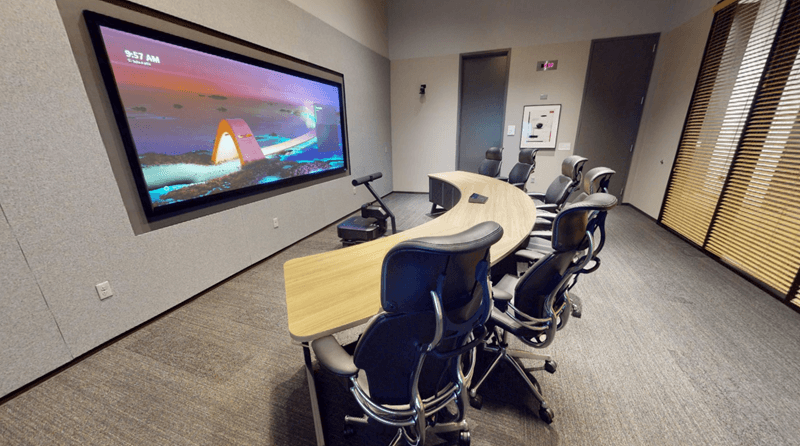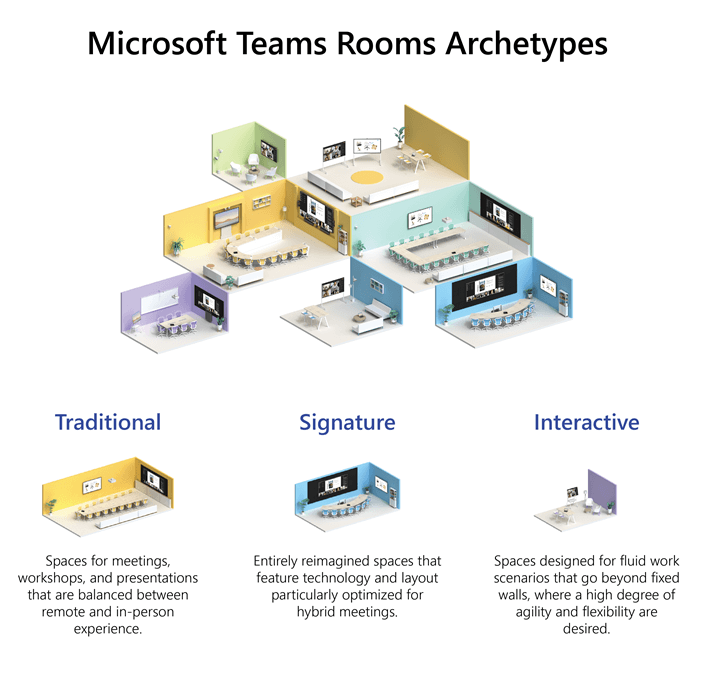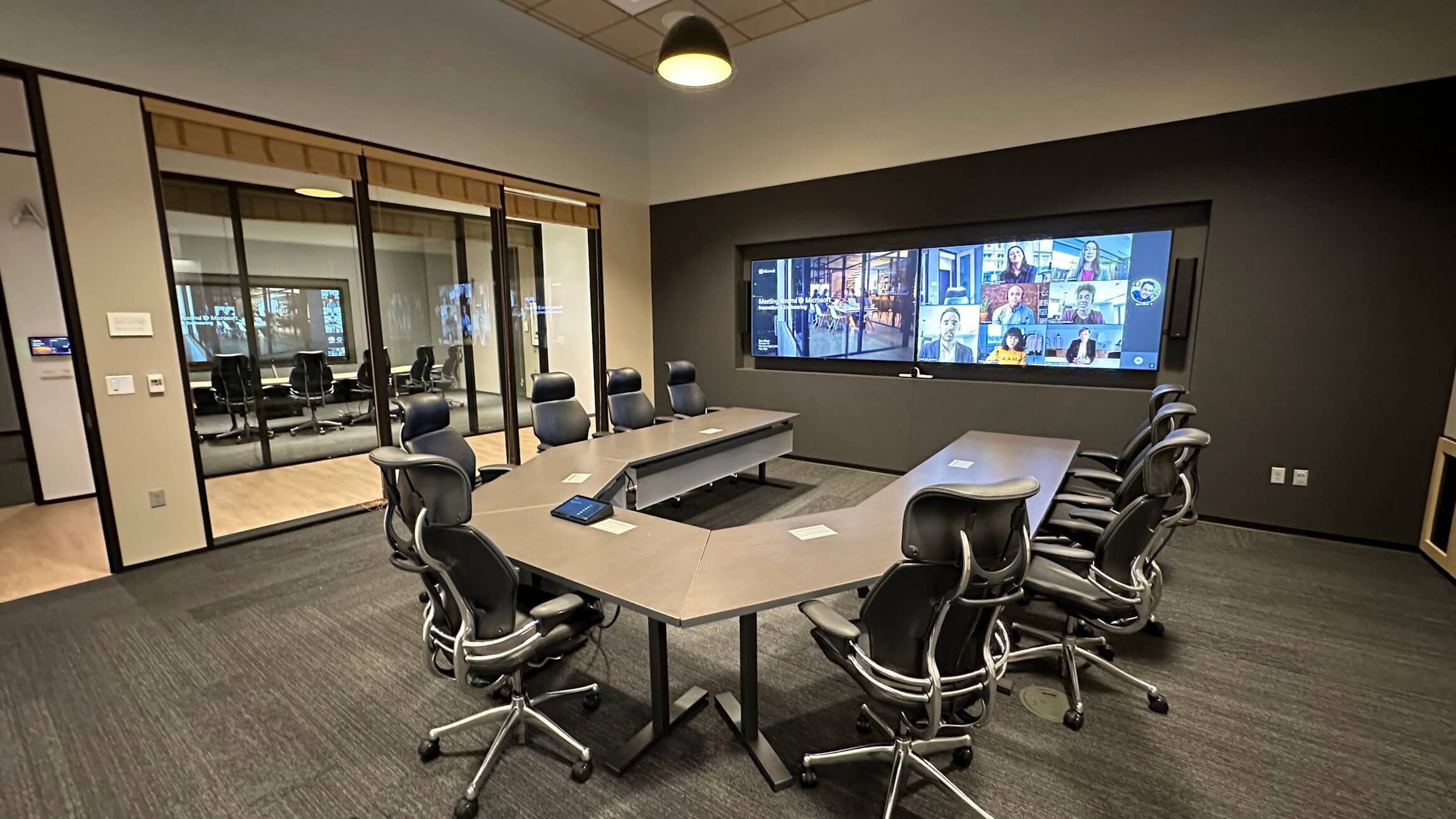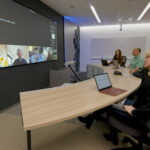 There’s been a lot of buzz around The Hive, our laboratory for building and testing new meeting room technology with Microsoft Teams Rooms.
There’s been a lot of buzz around The Hive, our laboratory for building and testing new meeting room technology with Microsoft Teams Rooms.
And for good reason—The Hive is where we in Microsoft Digital (MSD), Microsoft’s IT organization, create cutting-edge meeting experiences that get rolled into Microsoft Teams Rooms, our video conferencing product in Microsoft Teams.
Our aim is to create innovative, inclusive hybrid meeting experiences for both our employees here at Microsoft, and for our Microsoft Teams Rooms customers. What better way to show off what we’re doing than to bring customers into a real, live lab setting.
— Matthew Marzynski, principal product manager, MSD team, The Hive
Until recently, The Hive has been an internal-facing resource where we, with our partners in Global Workplace Services and the Microsoft Teams Product Group, experimented with ways to improve meeting experiences at Microsoft.
However, as the work-from-home movement took off and customer interest in what we were doing in The Hive exploded, we made the decision to invite customers into our lab.
“Our aim is to create innovative, inclusive hybrid meeting experiences for both our employees here at Microsoft and for our Microsoft Teams Rooms customers,” says Matthew Marzynski, a principal product manager on our MSD team at The Hive. “What better way to show off what we’re doing than to bring customers into a real, live lab setting.”
To this end, our team has built a new customer experience at The Hive that features live demonstrations that show customers how to visualize how Microsoft Teams Rooms function in different settings.
Magic laboratory tours
Tours at The Hive are kind of like a meeting technology “speed dating” experience. Rather than just presenting a slide deck, we take a hands-on approach, spinning up a meeting (complete with realistic bot attendees) across a variety of spaces so customers can experience different room sizes, technologies, and scenarios in one walk through the facility. We can even invite their remote colleagues in for an additional point of view.
“We bring customers into The Hive, tour them through, and demonstrate how Microsoft creates cutting-edge meeting experiences in hybrid work environments,” Marzynski says. “And then we share our processes and know-how to help them create their own inclusive hybrid work meeting experiences at their companies.”

The tours are so popular that interest far exceeds our team’s capacity. In response, we’ve launched a streaming series called “The Hive Live,” where we invite account teams and customers for a live guided tour of our facility and a Q&A with our experts. We’ve also built virtual room tours, where you can go online to see how actual Teams Rooms look and feel around our campuses. “It’s kind of like teleporting around a house you’re interested in on a real estate site,” Marzynski says.
Microsoft Teams Rooms are represented as about a dozen different archetypes ranging from a Focus room for four people to an executive boardroom for over 30 people. These function as design references to inspire and unblock customers.
“Internally, we go super-deep with room specifications down to the last cable and screw required in the room,” Marzynski says. “While we do share those, it can be confusing when facing down a hybrid-work transformation challenge. Archetype thinking helps customers get out the weeds and imagine how to scale out a common room experience across a whole real estate portfolio.” Ultimately, our team is focused on using The Hive to empower our customers to build their own experiences using Teams Rooms and other Microsoft technologies.
Building innovative hybrid meeting experiences
Interacting with external customers at The Hive has allowed us to more deeply understand our customers and their pain points. Understandably, we learned that customers want to create a welcoming, inclusive hybrid work environment while controlling costs.

We’re not just working with expensive, experimental, showy new technologies at The Hive. We have three points of view through which we evaluate our work there: Capability, collaboration, and cost.
Capability refers to what people can accomplish in a meeting space with the right technology. Collaboration alludes to how we take advantage of moments that matter to make collective effort in meetings as seamless and productive as possible, and cost translates as ensuring that we’re driving value and recommending the most durable investments in hybrid work experiences.
With these central ideas in mind, The Hive created an entirely reimagined meeting room that we’re now using across the company—the Signature Teams Room.
Signature is the most evolved embodiment of Microsoft Teams Rooms. It’s designed to provide a fully inclusive and collaborative meeting experience for all attendees, whether they’re joining remotely or in-person. It includes specialized furniture, displays, cameras, and audio devices that are arranged in a way that makes it easier for all attendees to engage with each other.
“It’s where the engineering of the technology and the design of the furniture and physical environment are fully integrated to create the most hybrid-friendly, inclusive experience possible,” Marzynski says.
One of the key features of a Signature Teams Room is a relocated central focal point for meeting attendees.
In a traditionally laid-out meeting room, the focal point of the meeting tends to be the center of a table, as it has been since meetings were invented. Remote participants tend to be off to the side of the room on a monitor, away from this focal point.
“Remote attendees can feel like observers, rather than participants, in a poorly thought-out traditional design,” Marzynski says. “You’re looking through what feels like a security camera, at a room of people that are sitting around a table, often facing away from you. And the in-room experience suffers as well, since everyone is forced to pay a cognitive tax to simultaneously balance two different types of interactions in two different parts of the room.”
By altering the room’s layout and selecting complementing hardware, Signature Teams Rooms have what is called a “circle of inclusion,” which welcomes in remote attendees and places them at natural eye gaze points. The result is that hybrid meetings feel more organic than in a traditionally designed room, like sitting around a half-digital, half-physical conversation circle.
Changes, such as shifting the meeting camera to be in between remote and in-person participants, make hybrid meetings more equitable. Employees are more likely to feel included and valued.
— Margie Strite, product marketing manager, Microsoft Teams
All Signature Teams Rooms have the following properties:
- In-person and remote attendees face each other
- Camera is at eye level
- Spatial audio can match a person’s voice to their location
- Remote participants have a clear view of everyone in the room
These seemingly small changes have a huge impact on how meetings are experienced.
Our solutions are very individualized. Signature Teams Rooms show customers how to optimize their spaces for hybrid work, so all employees have great meetings regardless of where they join from.
— Matt Hempey, lead principal group product manager, MSD Digital Workplace Productivity and Collaboration team
“Changes, such as shifting the meeting camera to be in between remote and in-person participants, make hybrid meetings more equitable,” says Margie Strite, a product marketing manager for Microsoft Teams. “Employees are more likely to feel included and valued.”
Other small shifts, such as including a content camera aimed at an analog whiteboard for meetings or including digital collaboration devices like the Surface Hub, offer ways to increase engagement between in-person and remote participants. The exact methods used and specifications for each Signature Teams Room built can vary for each customer and are based on their unique scenarios.
“Our solutions are very individualized,” says Matt Hempey, lead principal group product manager on the MSD Digital Workplace Productivity and Collaboration team at The Hive. “Signature Teams Rooms show customers how to optimize their spaces for hybrid work, so all employees have great meetings regardless of where they join from.”
At The Hive, we aim to design experiences that are as easy to deploy as possible. We’re introducing new features and innovations with our internal product teams and key industry partners to create a playbook that enhances meeting experiences across all of our room archetypes – while driving down cost and complexity.
— Sam Albert, principal product manager at The Hive
The Hive also concentrates on resourcefulness, deploying meeting rooms that provide excellent hybrid meeting experiences while limiting costs.
Reducing costs while upgrading meeting rooms
The reduction of cost is vital when building a new meeting room experience can cost as much as building a new house.
While some organizations might be comfortable spending large amounts of their budget to update and improve meeting rooms, many want to strike a balance between experience and cost-efficiency. This is largely why The Hive focuses on creating individualized solutions with its Signature Teams Rooms. Most of the time, a lot of energy is put into making the most of what already exists within a room, rather than remodeling everything. There are also new, modular solutions being built within Microsoft.
“At The Hive, we aim to design experiences that are as easy to deploy as possible,” says Sam Albert, a principal product manager at The Hive. “We’re introducing new features and innovations with our internal product teams and key industry partners to create a playbook that enhances meeting experiences across all of our room archetypes—while driving down cost and complexity.”
A new low-cost, modular approach to deploying room solutions that our experts designed at The Hive bypasses the usual built-in technology and keeps costs down, even when the technology needs to be updated in the future.
We designed the modular solution so that in-person presenters and remote participants can all view raised hands, the person speaking, and the content being presented. We wanted employees to feel heard, seen, and valued with this solution.
— Danielle Chelles-Blair, senior designer, MSD
For example, in a large multi-purpose room, this solution features a mobile pod that works with Microsoft Teams Rooms and is equipped with audience-facing cameras, a presenter-tracking camera, and scalable audio. During a meeting room refresh at Microsoft, this modular solution helped cut our cost by 75 percent as compared to how we would traditionally upgrade the same meeting room.
Despite being more cost-effective and less intensive than traditional solutions, the modular solution is still designed to create inclusive hybrid meeting experiences.
Customers don’t necessarily want to be their own guinea pigs. The experimentation that The Hive does, and shares insights from, really saves other organizations time, money, and effort spent on finding the best meeting experience solutions.
— Margie Strite, product marketing manager for Microsoft Teams
“We designed the modular solution so that in-person presenters and remote participants can all view raised hands, the person speaking, and the content being presented,” says Danielle Chelles-Blair, a senior designer in MSD. “We wanted employees to feel heard, seen, and valued with this solution.”

In addition to inclusivity and cost-savings, for many organizations, the reduced trial-and-error to find effective meeting experience solutions is a marked benefit of turning to The Hive.
“Customers don’t necessarily want to be their own guinea pigs,” Strite says. “The experimentation that The Hive does, and shares insights from, really saves other organizations time, money, and effort spent on finding the best meeting experience solutions.”
Go here to see and virtually experience a Signature Teams Room for yourself.
To sign up for an upcoming Hive Live session, browse our topics and register here.
If you’re thinking about getting started with Microsoft Teams Rooms, here are some tips to help you get started:
- Plan your deployment: Before you start deploying Microsoft Teams Rooms, it’s important to plan your deployment. This includes identifying the rooms where you want to deploy Microsoft Teams Rooms, selecting the right hardware, and ensuring that your network infrastructure is ready for video conferencing.
- Get familiar with the features: Microsoft Teams Rooms comes with a range of features that can help you make the most of your video conferencing experience. Some of these features include one-touch join, proximity detection, and content sharing. It’s important to get familiar with these features so that you can use them effectively during your meetings.
- Ensure that your devices are up-to-date: To ensure that you have the best possible experience with Microsoft Teams Rooms, it’s important to keep your devices up to date. This includes updating the firmware on your cameras, displays, and audio devices.
- Train your users: Finally, it’s important to train your users on how to use Microsoft Teams Rooms effectively. This includes teaching them how to join meetings, how to share content, and how to troubleshoot common issues.
Get started with Microsoft Teams Rooms.
- Read more about signature Microsoft Teams Rooms: A more inclusive and collaborative vision for hybrid meeting rooms.
- Discover crafting a new hybrid meeting room experience at Microsoft with Microsoft Teams.
- Explore deploying signature Microsoft Teams Rooms with generative AI.
- Unpack how Microsoft internally deploys signature Microsoft Teams Rooms.
Want more information? Email us and include a link to this story and we’ll get back to you.












